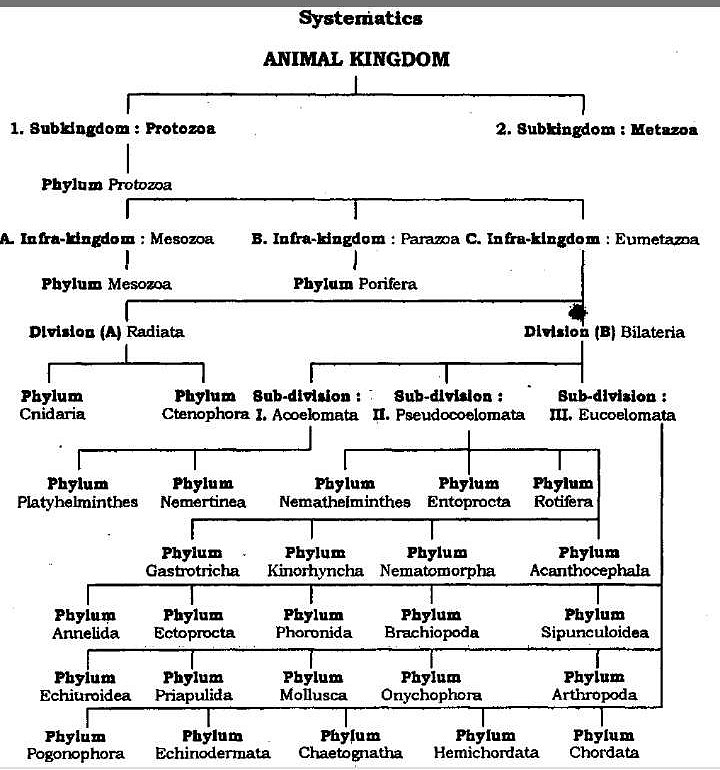NEET Exam > NEET Questions > Animal kingdom of classification.?
Start Learning for Free
Animal kingdom of classification.?
Community Answer
Animal kingdom of classification.?
Animal Kingdom Classification
The animal kingdom is one of the five kingdoms of classification that includes all animals. The classification of animals is based on their characteristics, including their body structure, behavior, and genetics. There are over 1.5 million identified species of animals, and more are discovered each year. Here's a breakdown of the animal kingdom classification:
Phylum
The highest level of classification in the animal kingdom is the phylum. Animals are grouped into different phyla based on their body structure and characteristics. There are over 30 different phyla, but the most commonly known are:
- Arthropoda (insects, spiders, crustaceans)
- Chordata (vertebrates, including mammals, birds, and fish)
- Mollusca (snails, clams, octopuses)
- Annelida (worms)
- Cnidaria (jellyfish, corals, anemones)
- Echinodermata (starfish, sea urchins)
Class
Each phylum is further divided into classes based on similarities in body structure and development. For example, the class Mammalia includes all animals that have mammary glands and hair. Other classes include Aves (birds), Reptilia (reptiles), and Amphibia (amphibians).
Order
Within each class, animals are further classified into orders based on even more specific characteristics. For example, the order Carnivora includes all meat-eating mammals, such as lions and wolves. Other orders include Primates (monkeys and apes), Rodentia (rodents), and Artiodactyla (hoofed mammals).
Family
Families are the next level of classification and group animals together based on shared characteristics. For example, the Felidae family includes all cats, while the Canidae family includes all dogs.
Genus and Species
The final level of classification is the genus and species. These are the two names given to every animal, such as Homo sapiens for humans. The genus is the broader group that animals belong to, while species is a more specific group within the genus.
Overall, the animal kingdom classification system is a way to organize and understand the vast variety of animals that exist on our planet. By grouping animals together based on shared characteristics, scientists can better understand their evolution, behavior, and relationships with other organisms.
Attention NEET Students!
To make sure you are not studying endlessly, EduRev has designed NEET study material, with Structured Courses, Videos, & Test Series. Plus get personalized analysis, doubt solving and improvement plans to achieve a great score in NEET.

|
Explore Courses for NEET exam
|

|
Similar NEET Doubts
Animal kingdom of classification.?
Question Description
Animal kingdom of classification.? for NEET 2024 is part of NEET preparation. The Question and answers have been prepared according to the NEET exam syllabus. Information about Animal kingdom of classification.? covers all topics & solutions for NEET 2024 Exam. Find important definitions, questions, meanings, examples, exercises and tests below for Animal kingdom of classification.?.
Animal kingdom of classification.? for NEET 2024 is part of NEET preparation. The Question and answers have been prepared according to the NEET exam syllabus. Information about Animal kingdom of classification.? covers all topics & solutions for NEET 2024 Exam. Find important definitions, questions, meanings, examples, exercises and tests below for Animal kingdom of classification.?.
Solutions for Animal kingdom of classification.? in English & in Hindi are available as part of our courses for NEET.
Download more important topics, notes, lectures and mock test series for NEET Exam by signing up for free.
Here you can find the meaning of Animal kingdom of classification.? defined & explained in the simplest way possible. Besides giving the explanation of
Animal kingdom of classification.?, a detailed solution for Animal kingdom of classification.? has been provided alongside types of Animal kingdom of classification.? theory, EduRev gives you an
ample number of questions to practice Animal kingdom of classification.? tests, examples and also practice NEET tests.

|
Explore Courses for NEET exam
|

|
Suggested Free Tests
Signup for Free!
Signup to see your scores go up within 7 days! Learn & Practice with 1000+ FREE Notes, Videos & Tests.


























